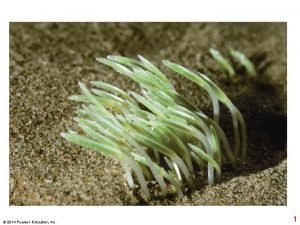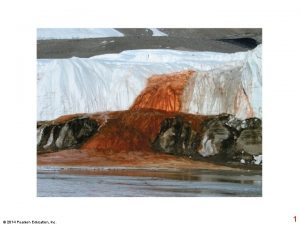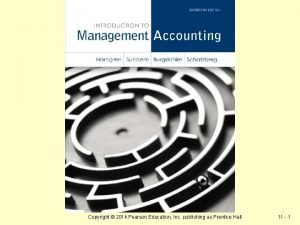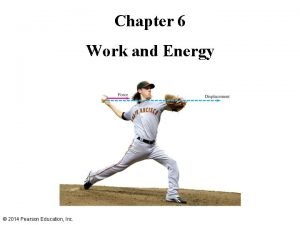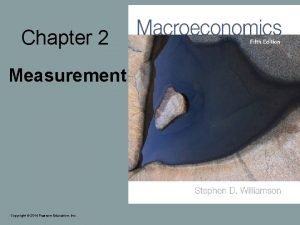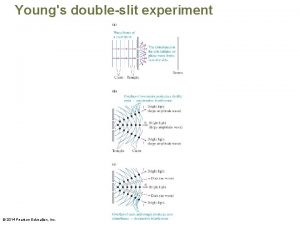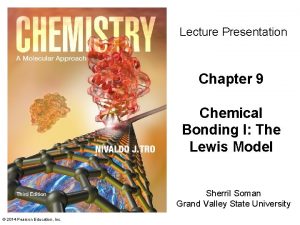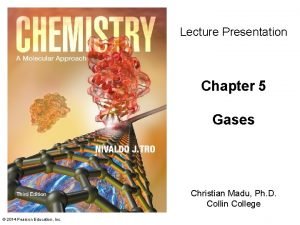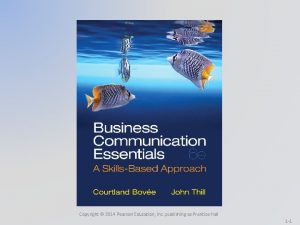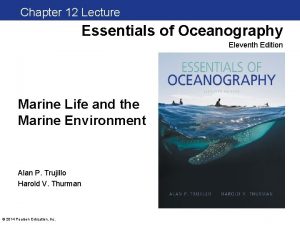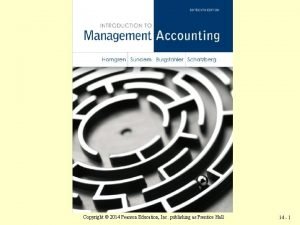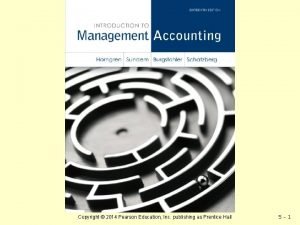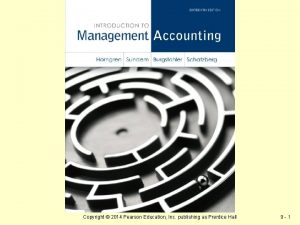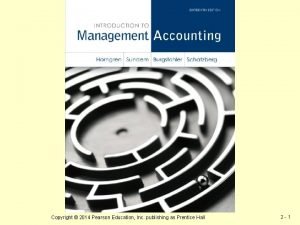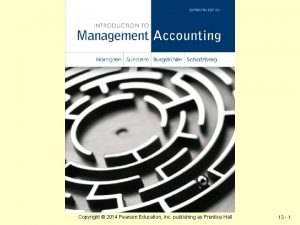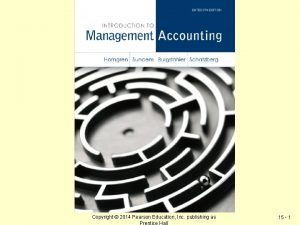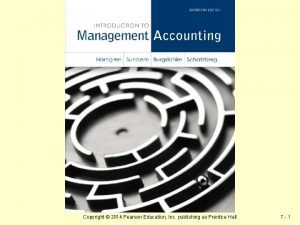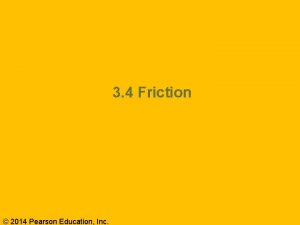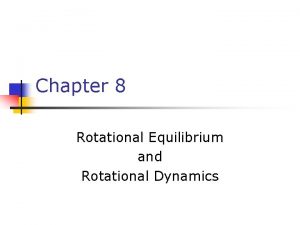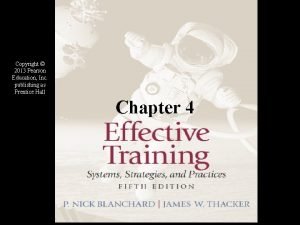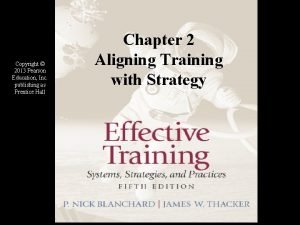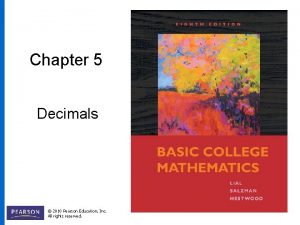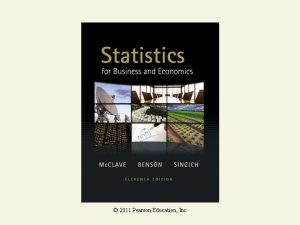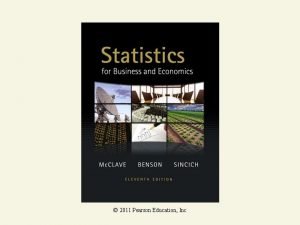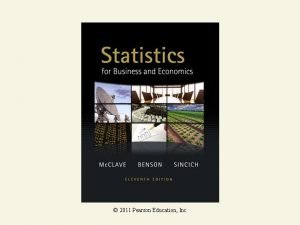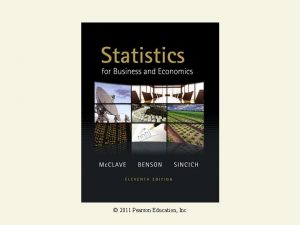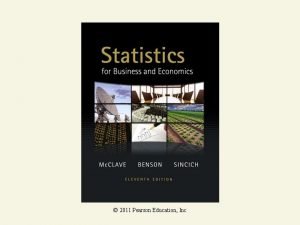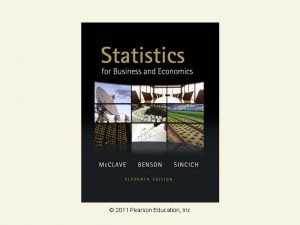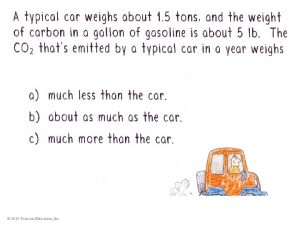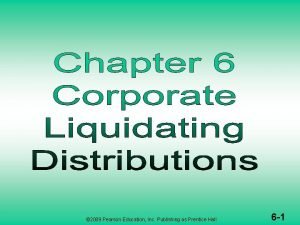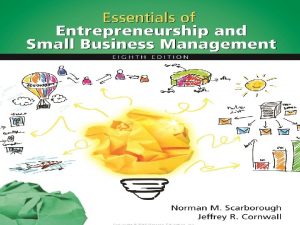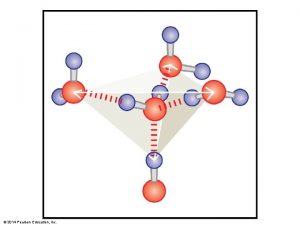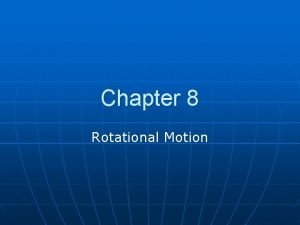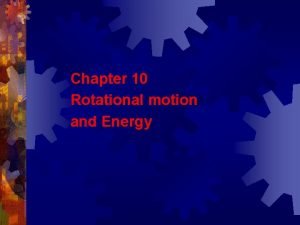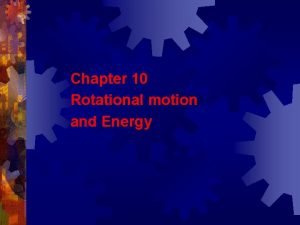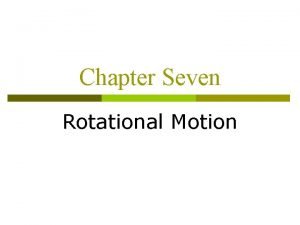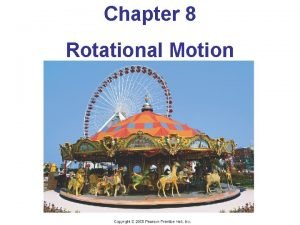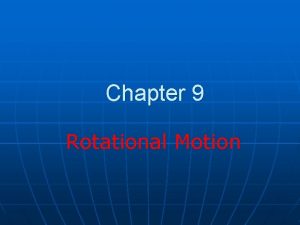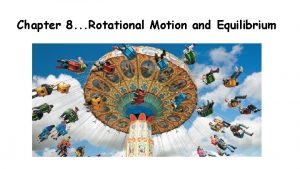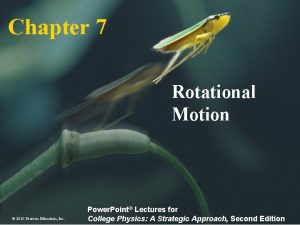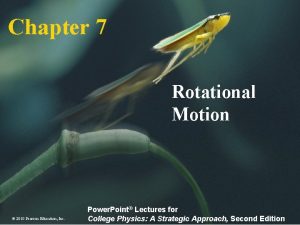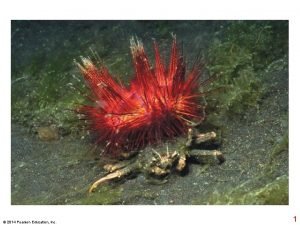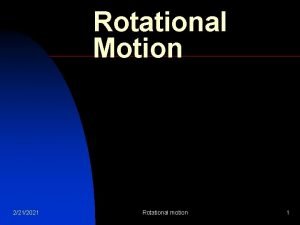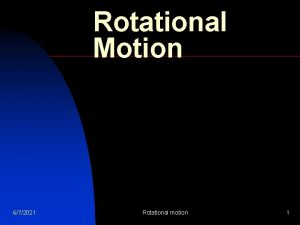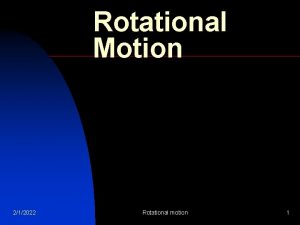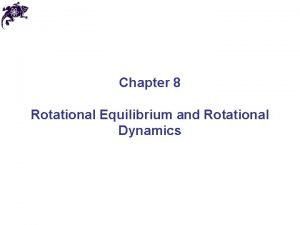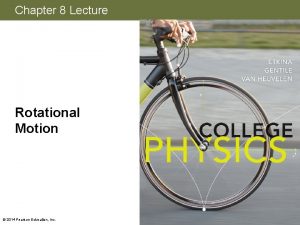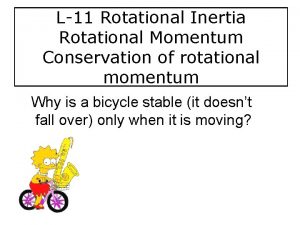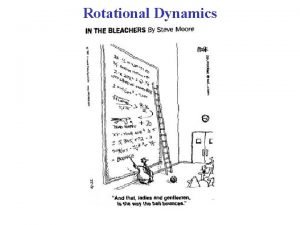Chapter 8 Rotational Motion 2014 Pearson Education Inc

























































![8 -7 Rotational Kinetic Energy [Remember the Ball in Cup Experiment? !] The kinetic 8 -7 Rotational Kinetic Energy [Remember the Ball in Cup Experiment? !] The kinetic](https://slidetodoc.com/presentation_image_h2/70d0e10668c1fb202658334911336699/image-58.jpg)


















- Slides: 76

Chapter 8 Rotational Motion © 2014 Pearson Education, Inc.

Contents of Chapter 8 • Angular Quantities • Constant Angular Acceleration • Rolling Motion (Without Slipping) • Torque • Rotational Dynamics; Torque and Rotational Inertia • Solving Problems in Rotational Dynamics © 2014 Pearson Education, Inc.

Contents of Unit 8 • Rotational Kinetic Energy • Angular Momentum and Its Conservation • Vector Nature of Angular Quantities • Torque and Rotational Motion © 2014 Pearson Education, Inc.

8 -1 Angular Quantities In purely rotational motion, all points on the object move in circles around the axis of rotation (“O”). The radius of the circle is r. All points on a straight line drawn through the axis move through the same angle in the same time. The angle θ in radians is defined: (8 -1 a) where l is the arc length. © 2014 Pearson Education, Inc.

8 -1 Angular Quantities In purely rotational motion, all points on the object move in circles around the axis of rotation (“O”). The radius of the circle is r. All points on a straight line drawn through the axis move through the same angle in the same time. The angle θ in radians is defined: (8 -1 a) where l is the arc length. © 2014 Pearson Education, Inc.

Radians and Degrees • © 2014 Pearson Education, Inc.

Radians and Degrees • Example 1: A bike wheel rotates 4. 50 revolutions. How many radians has it rotated? © 2014 Pearson Education, Inc.

Radians and Degrees • © 2014 Pearson Education, Inc.

Radians and Degrees • © 2014 Pearson Education, Inc.

Radians and Degrees • © 2014 Pearson Education, Inc.

Angular and Rotational Similarities • Side-By-Side Comparison between Linear and Angular © 2014 Pearson Education, Inc.

8 -1 Angular Quantities Angular displacement: Δθ = θ 2 – θ 1 The average angular velocity is defined as the total angular displacement divided by time: (8 -2 a) The instantaneous angular velocity: (8 -2 b) © 2014 Pearson Education, Inc.

8 -1 Angular Quantities Angular displacement: Δθ = θ 2 – θ 1 θ is unitless because it is represented by a length l and another length r so the units cancel The average angular velocity is defined as the total angular displacement divided by time: (8 -2 a) The instantaneous angular velocity: (8 -2 b) © 2014 Pearson Education, Inc.

8 -1 Angular Quantities Angular displacement: Δθ = θ 2 – θ 1 Does this remind you of Δd = d 2 – d 1? The average angular velocity is defined as the total angular displacement divided by time: (8 -2 a) Does this remind you of velocity? The instantaneous angular velocity: (8 -2 b) © 2014 Pearson Education, Inc.

8 -1 Angular Quantities The angular acceleration is the rate at which the angular velocity changes with time: (8 -3 a) The instantaneous acceleration: (8 -3 b) © 2014 Pearson Education, Inc.

8 -1 Angular Quantities The angular acceleration is the rate at which the angular velocity changes with time: Does this remind you of Δv = v – v ? 2 (8 -3 a) Does this remind you of acceleration? The instantaneous acceleration: (8 -3 b) © 2014 Pearson Education, Inc. 1

8 -1 Angular Quantities Every point on a rotating body has an angular velocity ω and a linear velocity v. They are related: (8 -4) Since ω is radians per second, r times ω yields m/s, linear velocity © 2014 Pearson Education, Inc.

8 -1 Angular Quantities Therefore, objects farther from the axis of rotation will move faster. © 2014 Pearson Education, Inc.

8 -1 Angular Quantities Therefore, objects farther from the axis of rotation will move faster. © 2014 Pearson Education, Inc.

8 -1 Angular Quantities Therefore, objects farther from the axis of rotation will move faster. © 2014 Pearson Education, Inc.

8 -1 Angular Quantities If the angular velocity of a rotating object changes, it has a tangential acceleration: (8 -5) Even if the angular velocity is constant, each point on the object has a centripetal acceleration: (8 -6) © 2014 Pearson Education, Inc.

8 -1 Angular Quantities Here is the correspondence between linear and rotational quantities: © 2014 Pearson Education, Inc.

8 -1 Angular Quantities The frequency is the number of complete revolutions per second: f = ω/2π Frequencies are measured in hertz. 1 Hz = 1 s− 1 The period is the time one revolution takes: (8 -8) © 2014 Pearson Education, Inc. ω is in radians per second so this also yields radians per second, whereas T equals seconds per radian

Is the Lion Faster than the Horse? Example 3: Is the lion faster than the horse? On a rotating carousel or merry-goround, one child sits on a horse near the outer edge and another child sits on a lion halfway out from the center. (a) Which child has the greater linear velocity? (b) Which child has the greater angular velocity? © 2014 Pearson Education, Inc.

Is the Lion Faster than the Horse? • © 2014 Pearson Education, Inc.

Is the Lion Faster than the Horse? • © 2014 Pearson Education, Inc.

Angular and Linear Velocities Example 4: A carousel is initially at rest. At t = 0 it is given a constant angular acceleration α =. 060 rad/s 2 which increases it angular velocity for 8. 0 s. At t = 8. 0 s , determine (a) the angular velocity of the carousel, and (b) the linear velocity of a child located 2. 5 m from the center of the carousel. © 2014 Pearson Education, Inc.

Angular and Linear Accelerations Example 5: For the child on the rotating carousel of the previous example, determine that child’s (a) tangential (linear) acceleration, (b) centripetal acceleration, (c) total acceleration. © 2014 Pearson Education, Inc.

8 -2 Constant Angular Acceleration The equations of motion for constant angular acceleration are the same as those for linear motion, with the substitution of the angular quantities for the linear ones. © 2014 Pearson Education, Inc.

8 -3 Torque A longer lever arm is very helpful in rotating objects. © 2014 Pearson Education, Inc.

8 -3 Torque Here, the lever arm for FA is the distance from the knob to the hinge; the lever arm for FD is zero; and the lever arm for FC is as shown. [It is easier for me to look at it as the FC component that is perpendicular to the lever, in this case the door. ] © 2014 Pearson Education, Inc.

8 -2 Torque The torque is defined as: © 2014 Pearson Education, Inc. (8 -10 a)

8 -3 Torque To make an object start rotating, a force is needed; the position and direction of the force matter as well. The perpendicular distance from the axis of rotation to the line along which the force acts is called the lever arm. © 2014 Pearson Education, Inc.

Torque Example 8: The biceps muscle exerts a vertical force on the lower arm, bent as shown. For each case, calculate the torque about the axis of rotation through the elbow joint, assuming the muscle is attached 5. 0 cm from the elbow axis. © 2014 Pearson Education, Inc.

Torque Example 8: The biceps muscle exerts a vertical force on the lower arm, bent as shown. For each case, calculate the torque about the axis of rotation through the elbow joint, assuming the muscle is attached 5. 0 cm from the elbow axis. We are only interested in the perpendicular force applied to the lever. Yes, you guessed it, more sine cosine! © 2014 Pearson Education, Inc.

Torque Example 8: The biceps muscle exerts a vertical force on the lower arm, bent as shown. For each case, calculate the torque about the axis of rotation through the elbow joint, assuming the muscle is attached 5. 0 cm from the elbow axis. We are only interested in the perpendicular force applied to the lever. Yes, you guessed it, more sine cosine! © 2014 Pearson Education, Inc.

Torque Why? 30 © 2014 Pearson Education, Inc.

Torque Why? Because forces parallel to the lever do not create torque. 30 © 2014 Pearson Education, Inc.

Torque 30 © 2014 Pearson Education, Inc. Only the red vector rotates the forearm toward the biceps. Conversely, the triceps does the reverse and counters the biceps.

Problem 25: Calculate the net torque about the axle of the wheel shown in the figure. Assume that a friction torque of. 60 Nm opposes the motion. “This is enough to make your axle spin!” “You can say that again. ” “This is enough to make your axle spin!” © 2014 Pearson Education, Inc.

Problem 25: Calculate the net torque about the axle of the wheel shown in the figure. Assume that a friction torque of. 60 Nm opposes the motion. © 2014 Pearson Education, Inc.

Problem 25: Calculate the net torque about the axle of the wheel shown in the figure. Assume that a friction torque of. 60 Nm opposes the motion. © 2014 Pearson Education, Inc.

Problem 29: Determine the net torque on the 2. 0 m long uniform beam shown in the figure. All forces are shown. Calculate the net torque about C and again about P. Note, here “about” means around. You’ve likely heard the term “coming about” for sailing, coming around is the layman’s term © 2014 Pearson Education, Inc.

Problem 29: Determine the net torque on the 2. 0 m long uniform beam shown in the figure. All forces are shown. Calculate the net torque about C and again about P. Note, here “about” means around. You’ve likely heard the term “coming about” for sailing, coming around is the layman’s term © 2014 Pearson Education, Inc.

8 -5 Rotational Dynamics; Torque and Rotational Inertia • © 2014 Pearson Education, Inc.

8 -5 Rotational Dynamics; Torque and Rotational Inertia As I was saying, knowing that F = ma, we see that τ = mr 2α This is for a single point mass; what about an extended object? As the angular acceleration is the same for the whole object, we can write: (8 -12) We separated the ∑τ=mr 2 from the alpha, because it has a special name and is called the property of… © 2014 Pearson Education, Inc.

8 -5 Rotational Dynamics; Torque and Rotational Inertia The quantity I = Σmr 2 is called the rotational inertia of an object. The distribution of mass matters here—these two objects have the same mass, but the on the top has a greater rotational inertia, as so much of its mass is far from the axis of rotation. © 2014 Pearson Education, Inc.

8 -5 Rotational Dynamics; Torque and Rotational Inertia The rotational inertia of an object depends not only on its mass distribution but also the location of the axis of rotation—compare (f) and (g), for example. © 2014 Pearson Education, Inc.

m = 10 kg R 1 = 2 m R 2 = 2. 2 m w =. 03 m Use these for f, g, h l=2 m w =. 5 m ? ? ? ? ? ? ? ? ? ? ? ? ? ? ? ? © 2014 Pearson Education, Inc.

m = 10 kg R 1 = 2 m R 2 = 2. 2 m w =. 03 m Use these for f, g, h l=2 m w =. 5 m ? ? ? ? ? ? ? ? ? ? ? ? © 2014 Pearson Education, Inc.

m = 10 kg R 1 = 2 m R 2 = 2. 2 m w =. 03 m Use these for f, g, h l=2 m w =. 5 m ? ? ? ? ? ? ? ? © 2014 Pearson Education, Inc.

m = 10 kg R 1 = 2 m R 2 = 2. 2 m w =. 03 m Use these for f, g, h l=2 m w =. 5 m ? ? ? ? © 2014 Pearson Education, Inc.

m = 10 kg R 1 = 2 m R 2 = 2. 2 m w =. 03 m Use these for f, g, h l=2 m w =. 5 m © 2014 Pearson Education, Inc.

Problem 8 -9: Two weights on a bar with different axes produce different I. Two small weights of mass 5. 0 kg and 7. 0 kg are mounted 4. 0 m apart on a light rod (ignore its mass) as shown in the figure. Calculate the moment of inertia of the system (a) when rotated about an axis halfway between the weights and (b) when rotated about an axis 0. 5. m to the left of the 5. 0 kg mass, as shown. © 2014 Pearson Education, Inc.

Problem 8 -9: Two weights on a bar with different axes produce different I. Two small weights of mass 5. 0 kg and 7. 0 kg are mounted 4. 0 m apart on a light rod (ignore its mass) as shown in the figure. Calculate the moment of inertia of the system (a) when rotated about an axis halfway between the weights and (b) when rotated about an axis 0. 5. m to the left of the 5. 0 kg mass, as shown. © 2014 Pearson Education, Inc.

Problem 8 -9: Two weights on a bar with different axes produce different I. Two small weights of mass 5. 0 kg and 7. 0 kg are mounted 4. 0 m apart on a light rod (ignore its mass) as shown in the figure. Calculate the moment of inertia of the system (a) when rotated about an axis halfway between the weights and (b) when rotated about an axis 0. 5. m to the left of the 5. 0 kg mass, as shown. © 2014 Pearson Education, Inc.

Demo Time with two setups… • Time 1—balanced bar • Time 2—unbalanced bar © 2014 Pearson Education, Inc.
![8 7 Rotational Kinetic Energy Remember the Ball in Cup Experiment The kinetic 8 -7 Rotational Kinetic Energy [Remember the Ball in Cup Experiment? !] The kinetic](https://slidetodoc.com/presentation_image_h2/70d0e10668c1fb202658334911336699/image-58.jpg)
8 -7 Rotational Kinetic Energy [Remember the Ball in Cup Experiment? !] The kinetic energy of a rotating object is given by KE = Σ(½ mv 2) By substituting the rotational quantities, we find that the rotational kinetic energy can be written: (8 -15) A object that has both translational and rotational motion also has both translational and rotational kinetic energy: (8 -16) © 2014 Pearson Education, Inc.

8 -6 Solving Problems in Rotational Dynamics Why not mg and FN? NOTE: This is Example 8 -10 from Giancoli 1. Draw a diagram. 2. Decide what the system comprises. 3. Draw a free-body diagram for each object under consideration, including all the forces acting on it and where they act. © 2014 Pearson Education, Inc.

8 -6 Solving Problems in Rotational Dynamics + 4. Find the axis of rotation, determine the positive direction for rotation and annotate it; calculate the torques around the axis of rotation. © 2014 Pearson Education, Inc.

8 -6 Solving Problems in Rotational Dynamics • © 2014 Pearson Education, Inc.

8 -6 Solving Problems in Rotational Dynamics • © 2014 Pearson Education, Inc.

A Clarification… © 2014 Pearson Education, Inc.

A Clarification… © 2014 Pearson Education, Inc.

8 -7 Rotational Kinetic Energy The torque does work as it moves the wheel through an angle θ: (8 -17) © 2014 Pearson Education, Inc.

8 -8 Angular Momentum and Its Conservation In analogy with linear momentum, we can define angular momentum L: (8 -18) [p = mv] We can then write the total torque as being the rate of change of angular momentum. If the net torque on an object is zero, the total angular momentum is constant. © 2014 Pearson Education, Inc. Iω = I 0ω0 = constant

8 -9 Vector Nature of Angular Quantities The angular velocity vector points along the axis of rotation; its direction is found using a right hand rule: © 2014 Pearson Education, Inc.

8 -9 Vector Nature…DJ’s question of “Why? ” © Hyper. Physics. com

8 -9 Vector Nature…DJ’s question of “Why? ” © Hyper. Physics. com

And this makes sense because the torque accelerates or decelerates the spin—imagine you turn the rod, fingers forward to accelerate and spin it fingers backwards to slow it down… © Hyper. Physics. com

8 -9 Vector Nature of Angular Quantities Angular acceleration and angular momentum vectors also point along the axis of rotation. © 2014 Pearson Education, Inc.

8 -7 Rotational Kinetic Energy When using conservation of energy, both rotational and translational kinetic energy must be taken into account. All these objects have the same potential energy at the top, but the time it takes them to get down the incline depends on how much rotational inertia they have. © 2014 Pearson Education, Inc.

8 -8 Angular Momentum and Its Conservation Therefore, systems that can change their rotational inertia through internal forces will also change their rate of rotation: © 2014 Pearson Education, Inc.

Summary of Chapter 8 • Angles are measured in radians; a whole circle is 2π radians. • Angular velocity is the rate of change of angular position. • Angular acceleration is the rate of change of angular velocity. • The angular velocity and acceleration can be related to the linear velocity and acceleration. © 2014 Pearson Education, Inc.

Summary of Chapter 8 • The frequency is the number of full revolutions per second; the period is the inverse of the frequency. • The equations for rotational motion with constant angular acceleration have the same form as those for linear motion with constant acceleration. • Torque is the product of force and lever arm. • The rotational inertia depends not only on the mass of an object but also on the way its mass is distributed around the axis of rotation. © 2014 Pearson Education, Inc.

Summary of Chapter 8 • The angular acceleration is proportional to the torque and inversely proportional to the rotational inertia. • An object that is rotating has rotational kinetic energy. If it is translating as well, the translational kinetic energy must be added to the rotational to find the total kinetic energy. • Angular momentum is L = Iω • If the net torque on an object is zero, its angular momentum does not change. © 2014 Pearson Education, Inc.
 2014 pearson education inc
2014 pearson education inc 2014 pearson education inc
2014 pearson education inc 2014 pearson education inc
2014 pearson education inc 2014 pearson education inc
2014 pearson education inc 2014 pearson education inc
2014 pearson education inc 2014 pearson education inc
2014 pearson education inc Water cycle pearson education
Water cycle pearson education 2014 pearson education inc
2014 pearson education inc 2014 pearson education inc
2014 pearson education inc 2014 pearson education inc
2014 pearson education inc 2014 pearson education inc
2014 pearson education inc 2014 pearson education inc
2014 pearson education inc 2014 pearson education inc
2014 pearson education inc 2014 pearson education inc
2014 pearson education inc 2014 pearson education inc
2014 pearson education inc 2014 pearson education inc
2014 pearson education inc 2014 pearson education inc
2014 pearson education inc 2014 pearson education inc
2014 pearson education inc Copyright 2014 pearson education inc
Copyright 2014 pearson education inc 2014 pearson education inc
2014 pearson education inc 2014 pearson education inc
2014 pearson education inc 2014 pearson education inc
2014 pearson education inc 2014 pearson education inc
2014 pearson education inc 2014 pearson education inc
2014 pearson education inc 2014 pearson education inc
2014 pearson education inc 2014 pearson education inc
2014 pearson education inc 2014 pearson education inc
2014 pearson education inc 2014 pearson education inc
2014 pearson education inc 2014 pearson education inc
2014 pearson education inc 2014 pearson education inc
2014 pearson education inc Pearson education, inc. publishing as prentice hall
Pearson education, inc. publishing as prentice hall 2011 pearson education inc
2011 pearson education inc Pearson education inc publishing as pearson prentice hall
Pearson education inc publishing as pearson prentice hall Pearson 2012
Pearson 2012 Pearson education inc publishing as pearson prentice hall
Pearson education inc publishing as pearson prentice hall Chapter 11 rotational equilibrium
Chapter 11 rotational equilibrium Rotational equilibrium
Rotational equilibrium 2018 pearson education inc
2018 pearson education inc Pearson education limited 2017
Pearson education limited 2017 Copyright pearson education inc
Copyright pearson education inc 2017 pearson education inc
2017 pearson education inc 2017 pearson education inc
2017 pearson education inc 2017 pearson education inc
2017 pearson education inc 2017 pearson education inc
2017 pearson education inc Pearson education inc 4
Pearson education inc 4 Pearson education, inc.
Pearson education, inc. 2013 pearson education inc
2013 pearson education inc 2013 pearson education inc
2013 pearson education inc 2013 pearson education inc. answers
2013 pearson education inc. answers 2013 pearson education inc
2013 pearson education inc Pearson education, inc. publishing as prentice hall
Pearson education, inc. publishing as prentice hall 2012 pearson education inc
2012 pearson education inc Pearson education inc. 2012
Pearson education inc. 2012 2010 pearson education inc
2010 pearson education inc 2010 pearson education inc
2010 pearson education inc 2009 pearson education inc
2009 pearson education inc 2016 pearson education inc
2016 pearson education inc Pearson education inc 5
Pearson education inc 5 2010 pearson education inc answers
2010 pearson education inc answers 2012 pearson education inc
2012 pearson education inc 2011 pearson education inc
2011 pearson education inc 2011 pearson education inc
2011 pearson education inc 2011 pearson education inc
2011 pearson education inc 2011 pearson education inc
2011 pearson education inc 2011 pearson education inc
2011 pearson education inc 2011 pearson education inc
2011 pearson education inc 2010 pearson education inc answers
2010 pearson education inc answers 2009 pearson education inc
2009 pearson education inc 2009 pearson education inc
2009 pearson education inc 2016 pearson education inc
2016 pearson education inc 2017 pearson education inc
2017 pearson education inc Pearson education inc 1
Pearson education inc 1 2016 pearson education inc
2016 pearson education inc 2016 pearson education inc
2016 pearson education inc Copyright pearson education inc
Copyright pearson education inc 2013 pearson education inc
2013 pearson education inc 2013 pearson education inc
2013 pearson education inc





